Weekly Forex Forecast - Sunday, Nov. 26
Image Source: Unsplash
The difference between success and failure in Forex trading is highly likely to depend upon which assets you choose to trade each week and in which direction, and not on the exact methods you might use to determine trade entries and exits.
So, when starting the week, it is a good idea to look at the big picture of what is developing in the market as a whole, and how such developments are affected by macro fundamentals, technical factors, and market sentiment.
Fundamental Analysis & Market Sentiment
I wrote in my previous piece on Nov. 19 that the best trade opportunities for the week were likely to be:
- Long of the Nasdaq 100 Index. This rose by 0.93% last week.
- Long of cocoa futures. This rose by 0.94% last week.
These trades produced an overall average win of 0.93%.
Last week was once again dominated by a decline in the US dollar, which arguably has established a new long-term bearish trend, and also a rise in US stock markets. Riskier currencies, such as the Australian dollar, the New Zealand dollar, and the British pound, rose firmly against the greenback.
The key driver of this was the lower-than-expected US and UK CPI (inflation) data releases, followed by low Canadian inflation, which suggest that the Fed is only going to be cutting rates, with markets pricing in total cuts of 0.50% by July 2024. With the Fed’s terminal rate seemingly having been reached already at 5.50%, the reversal in the monetary policy cycle from tightening to loosening is triggering bearish sentiment on the US dollar, and it is boosting stock markets and other risky assets as well.
The other major data release last week was the US FOMC Meeting Minutes, which tempered risk-on sentiment a bit as the meeting minutes showed members were remaining cautious about inflation, which was considered still overly elevated, and will not be rushing to begin cutting rates.
There were important developments concerning the Australian dollar, the euro, and the pound:
- The Reserve Bank of Australia’s Monetary Policy Meeting Minutes revealed unexpectedly hawkish rhetoric about demand-driven inflation, boosting the Australian dollar.
- The ECB’s Muller stated that further rate hikes are unlikely to be required, and the likelihood of this sentiment at the ECB has been causing relative weakness in the euro.
- Analysts expect the Bank of England to stand out as relatively hawkish going forward, with more rate hikes expected in the UK, which is boosting the pound.
Other important data releases within last week’s thin schedule were:
- US Unemployment Claims – this came in slightly lower than expected.
- US Revised UoM Consumer Sentiment – this came in roughly as expected.
- Flash Services & Manufacturing PMI for USA, UK, Germany, France – the data was mixed.
The Week Ahead: Nov. 27 - Dec. 1
The coming week in the markets is likely to see a somewhat higher level of volatility, as there will be more highly-important data releases. This week’s key data releases are, in order of importance:
- US Preliminary GDP
- US Core PCE Price Index
- German Preliminary CPI
- Spanish Flash CPI
- Australian CPI (inflation)
- RBNZ Official Cash Rate & Monetary Policy Statement
- Chinese Manufacturing PMI
- OPEC Meetings
- Canadian CPI (inflation)
- Canadian GDP
- US CB Consumer Confidence
- US Unemployment Change
- US ISM Manufacturing PMI
- Canadian Unemployment
Technical Analysis - US Dollar Index
The US Dollar Index printed a bearish candlestick last week, which closed near the low of its range. The weekly close was once again below the prices of both three and six months ago. These are bearish signs. Another bearish sign is that the price has more room to fall before reaching the nearest support level at 102.38.
This new dollar bearishness is supported by the lower-than-expected US inflation data released two weeks ago, which suggests that the Fed will now be working to cut rates rather than raise them. However, this was tempered a bit by the Fed minutes released last week showing ongoing concern about inflation remaining above its target rate of 2%.
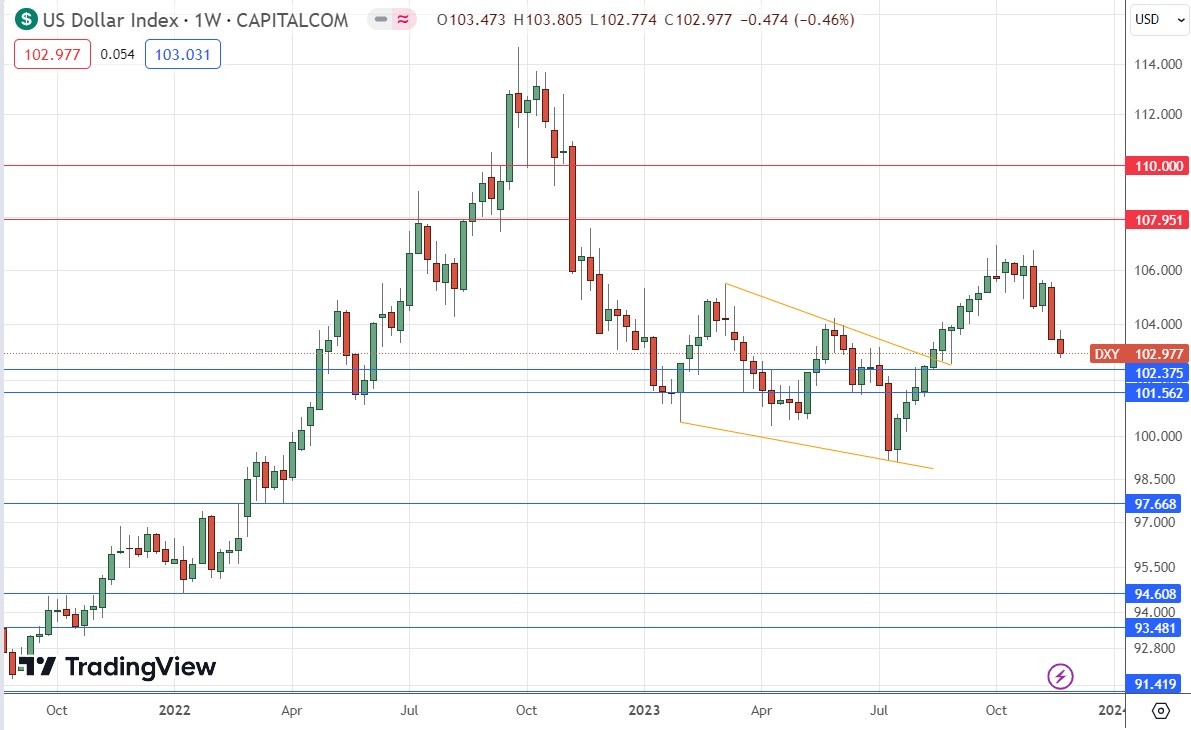
(Click on image to enlarge)
GBP/USD
The GBP/USD currency pair printed a solid bullish candlestick over the week, closing quite near the high of its range. The price ended the week by making its highest weekly close in three months.
Although these are bullish signs, bulls should beware the speed and suddenness of this bullish breakout, which suggests the price needs to spend some time consolidating or retracing before it will be safe to enter a new long trade here.
The British pound is one of the strongest major currencies right now, boosted by the perception that, unlike most other major central banks, the Bank of England will need to continue hiking its interest rate to get its relatively high inflation level down to the acceptable level of 2%.
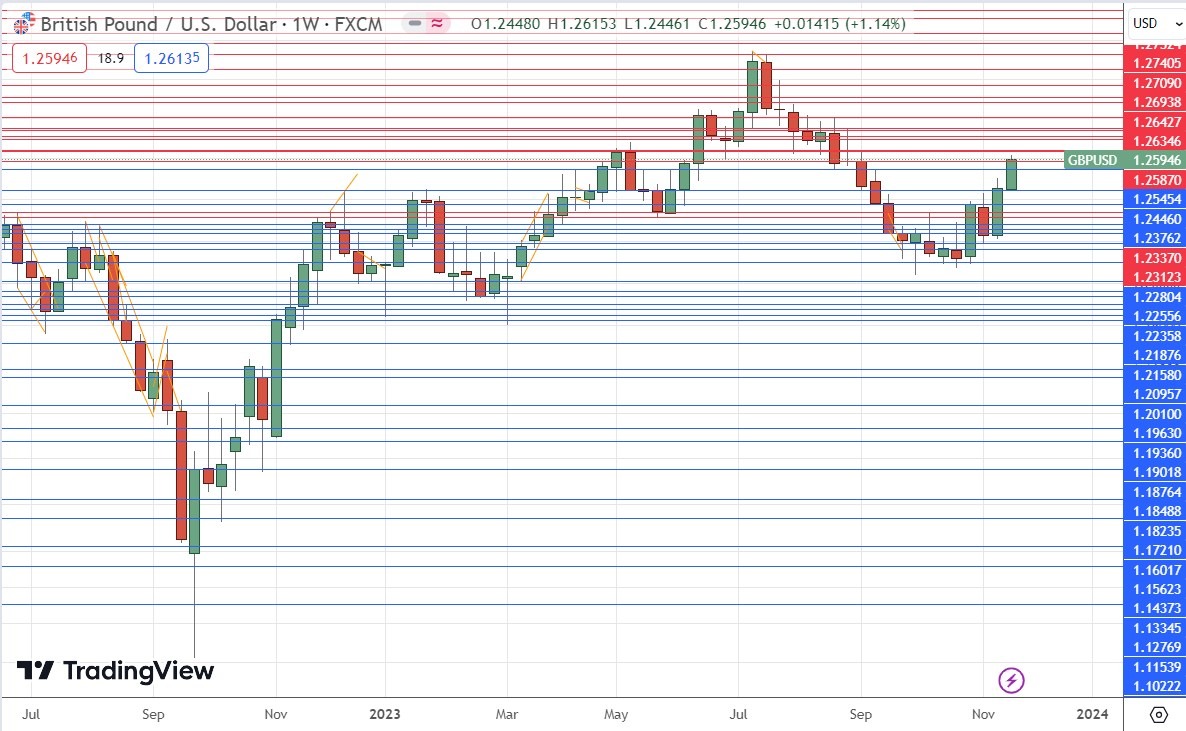
(Click on image to enlarge)
AUD/USD
The AUD/USD currency pair printed a solid bullish candlestick over the week, closing quite near the high of its range. The price ended the week by making its highest weekly close in 15 weeks. Although these are also bullish signs, bulls should once again beware the speed and suddenness of this bullish breakout.
The Australian dollar is similarly one of the strongest major currencies right now, boosted by the growth of risk sentiment and the RBA’s recent meeting minutes release, which showed continuing hawkishness on inflation. I will be more technically bullish if we start to see daily closes exceeding $0.6600.
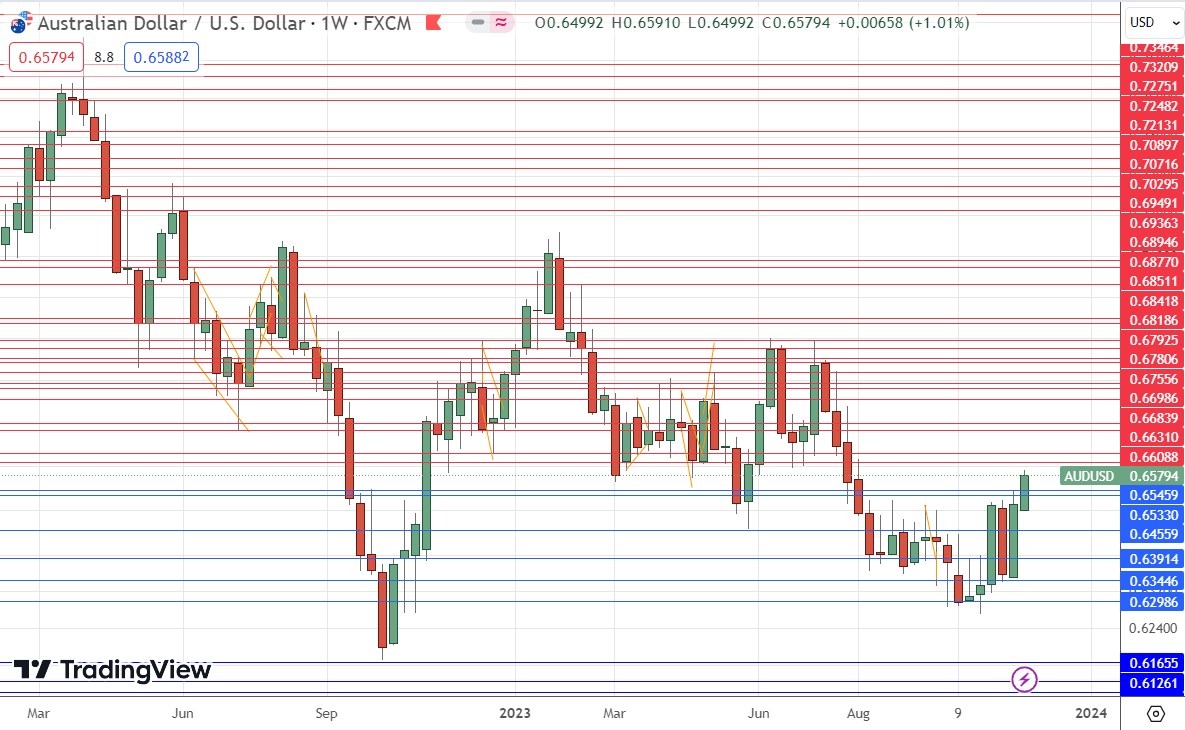
(Click on image to enlarge)
Nasdaq 100 Index
The Nasdaq 100 Index printed a fourth successive bullish candlestick, and it briefly traded at its highest price seen since January 2022. Despite these bullish facts, the momentum slowed considerably last week, but we clearly have a bull market here, which is breaking to new highs.
The Nasdaq 100 Index has historically been a great investment on the long side, especially during a bull market, and with this latest break to a new high, we seem to have a signal saying it makes sense to be long here. This approach will be validated by the inflation and central bank outlooks, which point towards decreasing inflationary pressure and a new more dovish, rate cutting approach by the Federal Reserve.
I am happy to be long of the Nasdaq 100 Index.
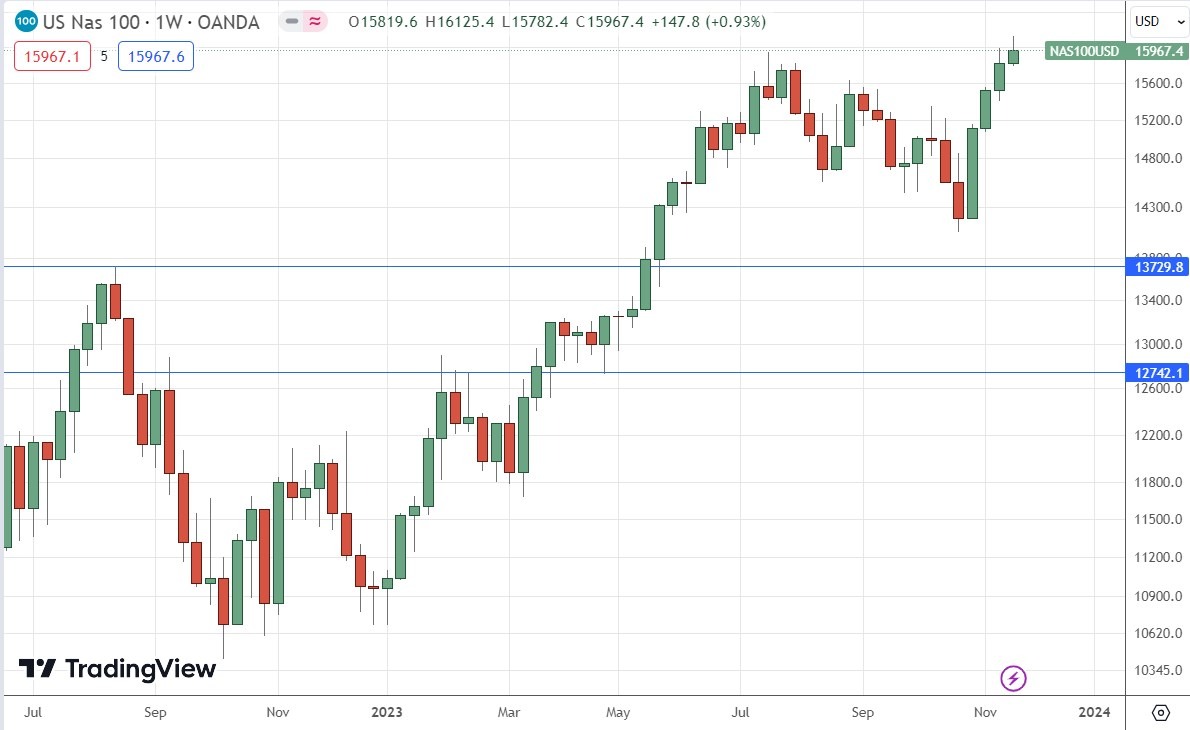
(Click on image to enlarge)
Cocoa Futures
Cocoa futures have been in a strong bullish trend for over a year now, and they saw another strong rise last week. The price chart below applies a linear regression analysis to the past 61 weeks, and it shows graphically what a great opportunity this has been on the long side. The weekly candlestick was bullish, although it is worth noting that the weekly close was below the previous week’s.
It is always a bit aggressive to enter without a pullback, especially right now with the price action above the upper band of the linear regression channel, but this is a strong trend that shows no sign of stopping on ever-increasing, global demand for cocoa.
It should be noted that trading commodities long on breakouts to new six-month highs has been a very profitable strategy over recent years.
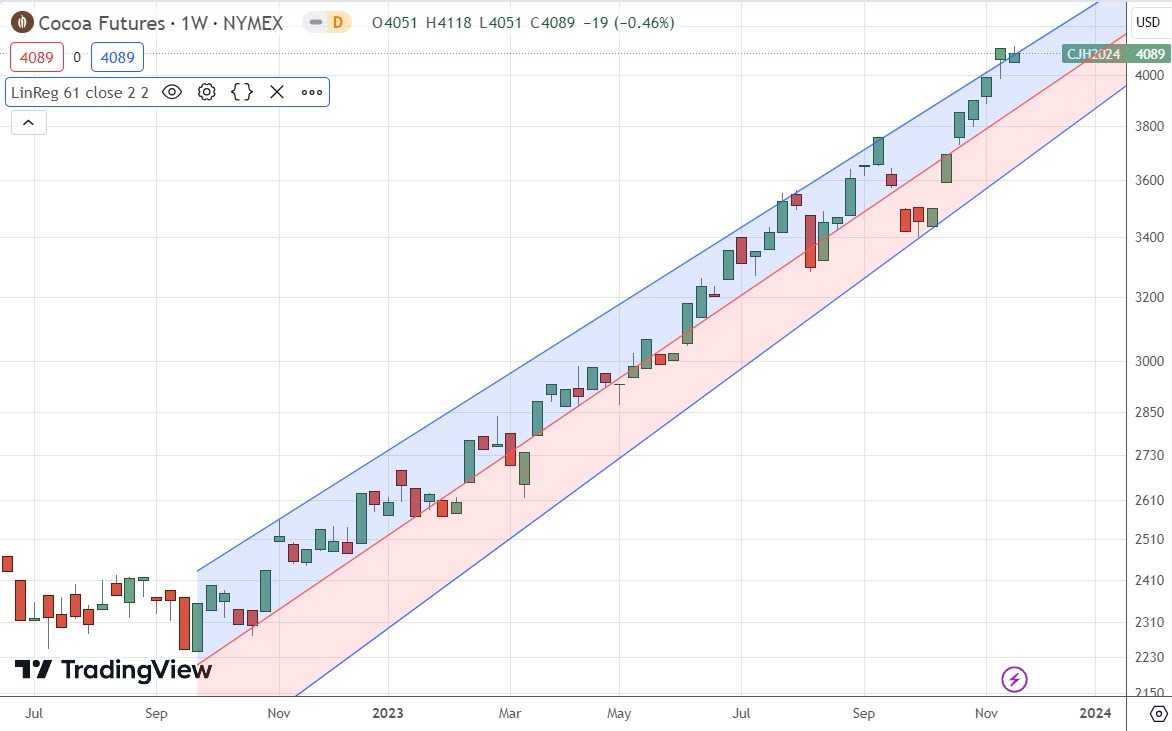
(Click on image to enlarge)
Bottom Line
I see the best trading opportunities this week as:
- Long of the Nasdaq 100 Index.
- Long of cocoa futures.
More By This Author:
Trading Support And Resistance - Sunday, Nov. 26
EUR/USD: Weekly Forecast November 26 - December 2
WTI Crude Oil: Weekly Forecast November 26 - December 2
Disclosure: DailyForex will not be held liable for any loss or damage resulting from reliance on the information contained within this website including market news, analysis, trading signals ...
more



